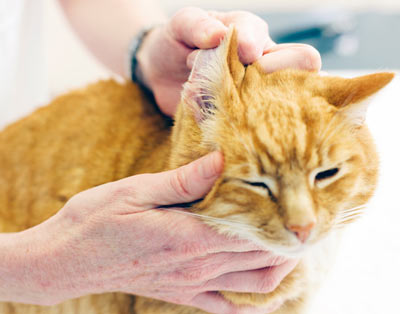Ear Hematomas in Cats

An ear hematoma occurs when space is created between the skin and cartilage in a cat's ear flap, and a broken blood vessel leaks into that space.
Causes of Ear Hematomas in Cats
Ear hematomas are caused by trauma to the ear flap(s). In cats, they are usually caused by an ear mite infestation, but they can be the result of anything that causes a cat to shake his head or scratch his ears violently.
Signs of Feline Aural Hematomas
Cats with an ear hematoma have swelling in one or both ear flaps. This might be a soft, small bubble anywhere in the flap, the entire flap may be swollen, large, and heavy, or anything in between. The tip of the ear flap may be weighed down by the hematoma.
Treatment of Ear Hematomas in Cats
Cats with ear hematomas may be treated in one or more of the following ways:
- The hematoma can be drained with a needle. This procedure, called aspiration, should only be performed by a veterinarian. The hematoma usually refills, requiring repeating the procedure or pursuing a different treatment option.
- Surgery to repair the space between the skin and cartilage of the ear flap. Anesthesia must be used for this procedure, and the skin of the ear flap is incised, the hematoma is drained, and then the skin is secured to the underlying cartilage with multiple sutures, which stay in place for several weeks before being removed.
- No treatment. An ear hematoma that is not otherwise treated will eventually be resorbed by the cat's body. Ear flaps that are allowed to heal this way may take months to fully resolve, and it almost always leaves the flap thickened and crinkled.
Regardless of how the veterinarian chooses to treat the ear hematoma, the underlying cause must also be addressed and treated aggressively. Ear mites, ear infection, allergies, or any other condition that causes the cat to shake his head or scratch his ears must be treated to allow the ear hematoma to heal and prevent it from recurring in the future.
You May Also Like These Articles:
Amazing Cat Facts to Know and Share
Cat Myths: Separating Fact from Fiction
How to Tell Cats You Love Them
Notice: Ask-a-Vet is an affiliated service for those who wish to speak with a veterinary professional about their pet's specific condition. Initially, a bot will ask questions to determine the general nature of your concern. Then, you will be transferred to a human. There is a charge for the service if you choose to connect to a veterinarian. Ask-a-Vet is not manned by the staff or owners of CatHealth.com, and the advice given should not delay or replace a visit to your veterinarian.



